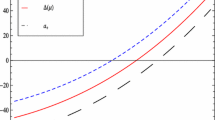Abstract
The computation of trapezoidal rule for the supersingular integrals on a circle in boundary element methods is discussed. When the singular point coincides with some priori known point, the convergence rate of the trapezoidal rule is higher than the global one which is considered as the superconvergence phenomenon. Then the error functional of density function is derived and the superconvergence phenomenon of composite trapezoidal rule occurs at certain local coordinate of each subinterval. At last, several numerical examples are provided to validate the theoretical analysis and show the efficiency of the algorithms.
Similar content being viewed by others
Explore related subjects
Discover the latest articles and news from researchers in related subjects, suggested using machine learning.References
Yu, D.H.: Natural Boundary Integrals Method and its Applications. Kluwer Academic Publishers, Berlin (2002)
Yu, D.H.: The approximate computation of hypersingular integrals on interval. Numer. Math. J. Chin. Univ. (English Ser.) 1, 114–127 (1992)
Zhang, X.P., Wu, J.M., Yu, D.H.: The superconvergence of composite trapezoidal rule for Hadamard finite-part integral on a circle and its application. Int. J. Comput. 87(4), 855–876 (2010)
Yang, C.X.: A unified approach with spectral convergence for the evaluation of hypersingular and supersingular integrals with a periodic kernel. J. Comput. Appl. Math. 239, 322–332 (2013)
Linz, P.: On the approximate computation of certain strongly singular integrals. Computing 35, 345–353 (1985)
Wu, J.M., Wang, Y.X., Li, W., Sun, W.W.: Toeplitz-type approximations to the Hadamard integral operator and their applications to electromagnetic cavity problems. Appl. Numer. Math. 58(2), 101–121 (2008)
Abdou, M.A.: Fredholm–Volterra integral equation with singular kernel. Appl. Math. Comput. 137, 231–243 (2003)
de Klerk, J.H.: Solving strongly singular integral equations by Lp approximation methods. Appl. Math. Comput. 127, 311–326 (2002)
Akel, M.S., Hussein, H.S.: Numerical treatment of solving singular integral equations by using Sinc approximations. Appl. Math. Comput. 218, 3565–3573 (2011)
Zhou, Y.T., Li, J., Yu, D.H., Lee, K.Y.: Numerical solution of hypersingular equation using recursive wavelet on invariant set. Appl. Math. Comput. 217, 861–868 (2010)
Monegato, G.: Numerical evaluation of hypersingular integrals. J. Comput. Appl. Math. 50, 9–31 (1994)
Choi, U.J., Kim, S.W., Yun, B.I.: Improvement of the asymptotic behaviour of the Euler-Maclaurin formula for Cauchy principal value and Hadamard finite-part integrals. Int. J. Numer. Methods Eng. 61, 496–513 (2004)
Wu, J.M., Yu, D.H.: The approximate computation of hypersingular integrals on interval. Chin. J. Numer. Math. Appl. 21, 25–33 (1999)
Frangi, A., Bonnet, M.: A direct approach for boundary integral equations with high-order singularities. Int. J. Numer. Methods Eng. 49, 871–898 (2000)
Hasegawa, T.: Uniform approximations to finite Hilbert transform and its derivative. J. Comput. Appl. Math. 163, 127–138 (2004)
Hui, C.Y., Shia, D.: Evaluations of hypersingular integrals using Gaussian quadrature. Int. J. Numer. Methods Eng. 44, 205–214 (1999)
Ioakimidis, N.I.: On the uniform convergence of Gaussian quadrature rules for Cauchy principal value integrals and their derivatives. Math. Comp. 44, 191–198 (1985)
Kim, P., Jin, U.C.: Two trigonometric quadrature formulae for evaluating hypersingular integrals. Inter. J. Numer. Methods Eng. 56, 469–486 (2003)
Li, J., Wu, J.M., Yu, D.H.: Generalized extrapolation for computation of hypersingular integrals in boundary element methods. CMES. Comput. Model. Eng. Sci. 42(2), 151–175 (2009)
Li, J., Yu, D.H.: The superconvergence of certain two-dimensional Cauchy Principal value integrals. CMES Comput. Model. Eng. Sci. 71, 331–346 (2011)
Li, J., Yu, D.H.: The superconvergence of certain two-dimensional Hilbert singular integrals. CMES Comput. Model. Eng. Sci. 82, 233–252 (2011)
Li, J., Yu, D.H.: The erroe estimate of Newton-Cotes methods to compute hypersingular integral. Math. Numer. Sin. 33, 77–86 (2011)
Li, J., Zhang, X.P., Yu, D.H.: Superconvergence and ultraconvergence of Newton-Cotes rules for supersingular integrals. J. Comput. Appl. Math. 233, 2841–2854 (2010)
Li, J., Zhang, X.P., Yu, D.H.: Extrapolation methods to compute hypersingular integral in boundary element methods. Sci. Chin. Math. 56(8), 1647–1660 (2013)
Du, Q.K.: Evaluations of certain hypersingular integrals on interval. Int. J. Numer. Methods Eng. 51, 1195–1210 (2001)
Li, J., Yu, D.H.: Error expansion of classical Trapezoidal rule for computing Cauchy Principal value integral. CMES Comput. Model. Eng. Sci. 93, 47–67 (2013)
Li, J., Li, X.Z.: The modified trapezoidal rule for computing hypersingular integral on interval. J. Appl. Math. 2013(736834), 9 (2013). doi:10.1155/2013/736834
Wu, J.M., Sun, W.W.: The superconvergence of the composite trapezoidal rule for Hadamard finite part integrals. Numer. Math. 102, 343–363 (2005)
Zhang, X.P., Wu, J.M., Yu, D.H.: Superconvergence of the composite Simpsons rule for a certain finite-part integral and its applications. J. Comput. Appl. Math 223, 598–613 (2009)
Li, J., Rui, H.X., Yu, D.H.: Composite Simpsons rule for computing supersingular integral on circle. CMES 97(6), 463–481 (2014)
Andrews, L.C.: Special Functions of Mathematics for Engineers. McGraw-Hill Inc, NewYork (1992)
Acknowledgments
The work of Li was supported by National Natural Science Foundation of China (Grant Nos. 11471195, 11201209 and 91330106), China Postdoctoral Science Foundation fund project ( No. 2013M540541). The work of Rui was supported by National Natural Science Foundation of China (No. 91330106).
Author information
Authors and Affiliations
Corresponding author
Appendix
Appendix
For the case \(p=2\), by the definition of (3), we have
where we have used the identity
and
For the case \(p=1\), we have

Rights and permissions
About this article
Cite this article
Li, J., Rui, H. & Yu, D. Trapezoidal Rule for Computing Supersingular Integral on a Circle. J Sci Comput 66, 740–760 (2016). https://doi.org/10.1007/s10915-015-0042-3
Received:
Revised:
Accepted:
Published:
Issue Date:
DOI: https://doi.org/10.1007/s10915-015-0042-3



